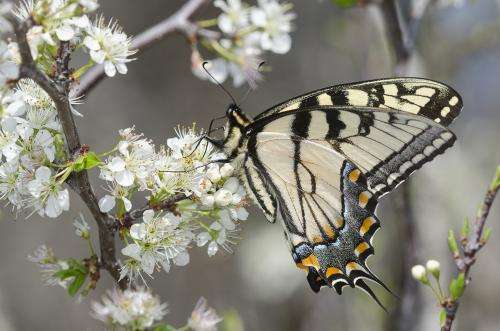How the Eastern tiger swallowtail got 'scary'

As butterflies go, the Eastern tiger swallowtail is pretty scary. Their caterpillars look more like stubby snakes, complete with a fake green head, faux black and yellow eyes, and an orange, forked, fleshy "tongue." That tongue-like structure (officially called an osmeterium) can evert, expand, and move, releasing a stinky substance in the process.
Scientists know a lot about these popular butterflies - which are honored as the state insect in five states despite the appearance and odor associated with their young - but they hadn't managed to sequence their genome. Now, researchers writing in the Cell Press journal Cell Reports on February 12th have sequenced the complete genome of one wild-caught individual, and they say that it has already told them more than they had anticipated about the butterflies and some of their most intriguing features.
The report also shows that it's now possible to buy the genome of essentially any wild insect for a very reasonable price. That ability opens the door for sequencing many more genomes at an even faster pace, which is necessary if scientists are going to get better at learning to predict or perhaps even change an animal's characteristics based on their DNA alone.
"With our protocols, the cost per new genome falls below $4,000, making insect sequencing projects feasible for college and, in the foreseeable future, high school students," said Nick Grishin of the University of Texas Southwestern Medical Center. "Go out, catch a bug, sequence the genome, learn something new. Isn't it wonderful?"
Now back to those swallowtails: Grishin said their primary goal was really to devise a way to sequence genomes with high levels of genetic variation at a reasonable cost, but they were in for some surprises. The genome data uncovered mutations in proteins that are responsible for the circadian rhythm, which might explain why Eastern tiger swallowtails break free of their chrysalises right away instead of sleeping through the winter as their cousins the Canadian tiger swallowtails must do.

They also found something that appears to explain where the caterpillars got that stinky substance they use to scare off predators. The analysis shows that a gene encoding enzymes that synthesize stinky terpenes got multiplied in the swallowtail genome. The butterflies have many diverse proteins in the family instead of just one or two.
Cool as the Eastern tiger swallowtails may be, the new findings are just the beginning of many more butterfly genomes yet to come. "We think the power of comparative genomics can be fully exploited only when there are thousands of genomes available," Grishin said. Stay tuned.
More information: Cell Reports, Cong et al.: "Tiger Swallowtail genome reveals mechanisms for speciation and caterpillar defense" www.cell.com/cell-reports/abst … 2211-1247(15)00051-0
Journal information: Cell Reports
Provided by Cell Press

















